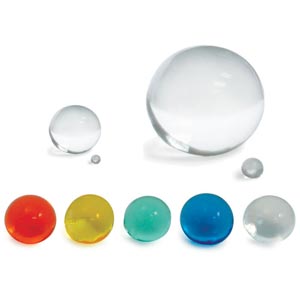 Photographing Science
Photographing Science
by: Martin Sagendorf
It’s Easy:
To take neat photos of little things.
We Think: Read the rest of this entry »
 Photographing Science
Photographing Scienceby: Martin Sagendorf
It’s Easy:
To take neat photos of little things.
We Think: Read the rest of this entry »
 by: John Fedors
by: John Fedors
Hydrophilic spheres from Educational Innovations offer a variety of interesting applications and opportunities for scientific inquiry. They come in a variety of sizes: regular, jumbo, & gigantic. For the following examples, I prefer the regular or #710 size. However, whichever size you choose, they will expand to about 300 times their original dehydrated size.
 As they absorb the water, they become almost invisible, due to having the same refractive index as water. When placed in de-mineralized or distilled water and kept away from sunlight, they will dehydrate to their original size and can be re-used. Dehydration time will depend on air humidity.
As they absorb the water, they become almost invisible, due to having the same refractive index as water. When placed in de-mineralized or distilled water and kept away from sunlight, they will dehydrate to their original size and can be re-used. Dehydration time will depend on air humidity.
Once enlarged, these clear spheres can be used to demonstrate:
* The lens of an eye (such as those of a shark, calf or sheep) that has the ability to magnify the print on a page. A thin slice may be used to mimic a cornea transplant.
* The suspension of small items such as a coin.
* Roots of a germinating seed.
Enlarged growing spheres can also help to observe the relationship of Surface Area (A=4pr2) to Volume (V=4/3pr3) mass in grams. They can be used to graph relationships. Read the rest of this entry »
 by: Martin Sagendorf
by: Martin Sagendorf
One Pendulum…
Is interesting, but…
Two Pendulums…
Are much more interesting.
 by: Martin Sagendorf
by: Martin Sagendorf
Clocks measure time – it can be a continuous measure of events passing or the measure of the interval between two events.
After years of evolution, our modern clocks now divide the day into 24 equal length hours. And, as we know, there are two systems in use today: Americans use the “double-twelve” system while the rest of the world uses the 24 hour system.
The word “hour’ comes from the Latin and Greek words meaning season, or time of day. A “minute” from the medieval Latin pars minuta prima (first minute or small part), originally described the one-sixtieth of a unit in the Babylonian system of sexagesimal fractions. And “second” from partes minutae secundae, was a further subdivision on the base of sixty – i.e. “a second minute”. (ref. Pg. 42 The Discoverers by Daniel J. Boorstin)
Has 12 at the top – probably because at noon the sun is at its highest point in the sky.
We can make a clock with 12 o’clock anywhere we wish and the clock will still work just fine. Read the rest of this entry »